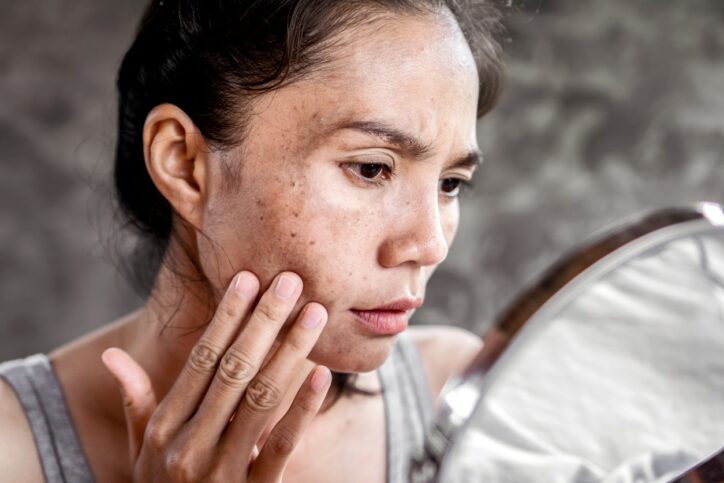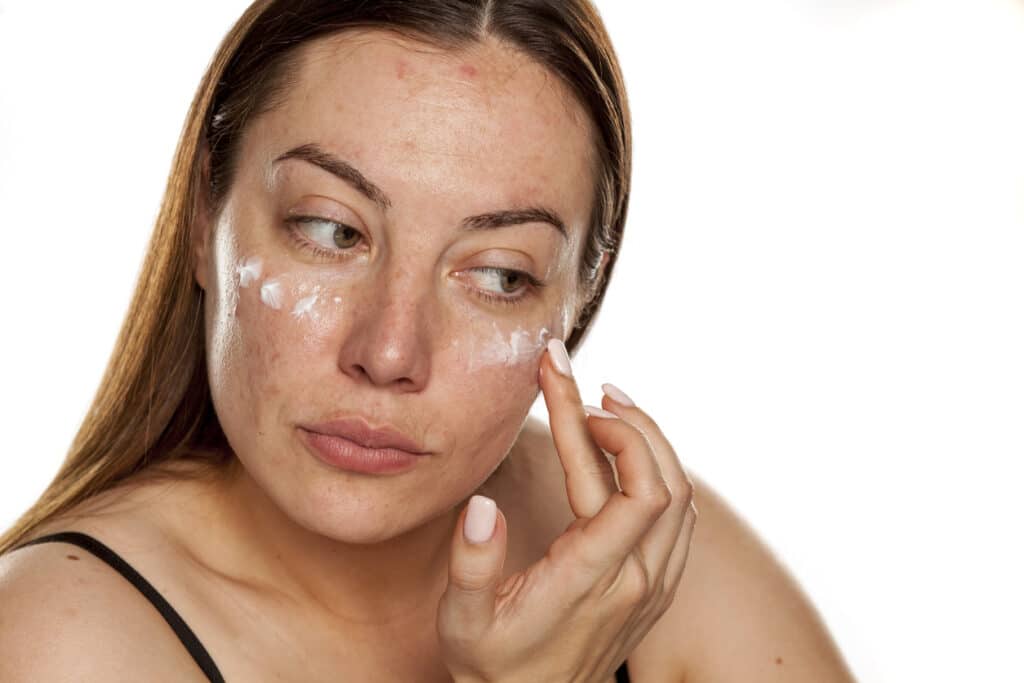How to Naturally Get Rid of Sunspots
January 6, 2022 by VitalSkin Dermatology

Sunspots are a condition many of us develop over time that creates unsightly dark spots around the face and forehead. This skin condition can leave you feeling self-conscious and layering on the BB cream or foundation every time you leave the house. There are many natural remedies out there, however, that can help fade these spots over time, returning your skin tone to an even-toned appearance.
What are Sun Spots?
Sunspots, also known as solar lentigines, are dark patches that appear on the skin as a result of prolonged sun exposure. These flat, tan, or brown spots are most commonly found on areas of the body that are frequently exposed to the sun, such as the face, hands, shoulders, and arms. Sunspots are caused by an increase in melanin production in the skin, which is the body’s way of trying to protect itself from the harmful effects of the sun’s UV rays. While sunspots are generally harmless and do not require medical treatment, they can be a cosmetic concern for many individuals.
How to Get Rid of Sun Spots Naturally
Nature provides us with a wealth of ingredients that can help fade sunspots and restore the skin’s natural radiance. These natural ingredients are packed with antioxidants, vitamins, and minerals that nourish and protect the skin, promoting a more even skin tone and reducing the appearance of sunspots. Here are some of the most effective natural remedies for sun spots:
Aloe Vera
Aloe vera has been a trusted, natural skincare product for some time now. It is known for its soothing and healing properties. It contains enzymes that help repair damaged skin cells and promote the regeneration of new, healthy cells. Apply fresh aloe vera gel directly to the sunspots and leave it on for 30 minutes before rinsing off.
Vitamin C
A natural antioxidant, Vitamin C in the form of topical L-ascorbic acid can promote collagen production and may be effective in lightening sunspots. Many high-quality skin products contain this ingredient, including some prescription products. You can consult with your dermatologist as to their recommendations when it comes to using this essential skincare antioxidant.
Vitamin E
Vitamin E is commonly applied to the skin in oil form and is a key component in many popular skin oils on the market today. This natural antioxidant has been shown in research to have a positive effect on areas of the skin that have been photo-damaged and may protect the skin against further light damage moving forward.
Apple Cider Vinegar
Apple cider vinegar is a natural astringent that can help lighten sunspots and even out the skin tone. Dilute apple cider vinegar with equal parts water and apply it to the affected areas using a cotton ball. Leave it on for 5-10 minutes before rinsing off. Start with a lower concentration of apple cider vinegar and gradually increase it as your skin tolerates it.
Glycolic Acid
Glycolic acid is one of the strongest performers when it comes to fading sunspots and, yes, it’s natural. Glycolic acid can be sourced from natural substances and is one of the most effective techniques for fading the dark discoloration of hyperpigmentation.
Hydroxy Acids
Hydroxy acids also do very well in fading hyperpigmentation. They are often used in topical treatments for acne, due to their resurfacing capabilities. AHAs, or alpha hydroxy acids, may have an impact on sunspots and other discoloration of the skin.
Lemon Juice
Lemon juice is a natural bleaching agent that can help lighten the appearance of sunspots. It contains citric acid, which exfoliates the skin and promotes cell turnover, revealing fresher and brighter skin underneath. Simply apply fresh lemon juice to the affected areas using a cotton ball, leave it on for 10-15 minutes, and rinse off with lukewarm water.
Over-the-Counter Creams
There are several topical creams on the market today that include many natural ingredients, including popular remedies such as Vitamins E and C. Working in consultation with your dermatologist, you can select a range of OTC creams that leverage these ingredients, as well as glycolic acids and hydroxy acids. Your dermatologist may also have recommendations as to prescription treatments or in-office procedures that can be used to help fade sunspots.
How to Prevent Sun Spots
Prevention is key when it comes to sunspots. Incorporating a consistent skincare routine into your daily life can help protect your skin from the harmful effects of the sun and minimize the risk of sunspot formation. Here are some essential steps to include in your skincare routine:
- Cleansing: Cleanse your face twice a day using a gentle cleanser to remove dirt, oil, and impurities from the skin. Avoid using harsh cleansers that can strip away the skin’s natural oils, as this can lead to dryness and sensitivity.
- Toning: After cleansing, apply a toner to help balance the skin’s pH levels and remove any remaining traces of dirt or impurities. Look for toners that contain soothing ingredients like rose water or witch hazel.
- Moisturizing: Hydrate your skin with a moisturizer that suits your skin type. Moisturizers help lock in moisture and create a protective barrier on the skin, keeping it hydrated and nourished. Look for moisturizers that contain ingredients like hyaluronic acid, which can help plump the skin and reduce the appearance of sunspots.
- Sunscreen: Apply a broad-spectrum sunscreen with an SPF of 30 or higher every day, even on cloudy days or during the winter months. Sunscreen is the most crucial step in preventing sunspots, as it helps shield your skin from the harmful effects of UV rays. Look for sunscreens that offer both UVA and UVB protection.
- Exfoliation: Exfoliate your skin once or twice a week to remove dead skin cells and promote cell turnover. This helps to fade existing sunspots and prevent the formation of new ones. Choose a gentle exfoliator that suits your skin type and avoid over-exfoliating, as this can cause irritation and damage to the skin.

Working With Your Dermatologist
There are many ‘natural’ ways to treat sunspots. Perhaps the most effective approach is to work in partnership with your dermatologist. They can develop a comprehensive treatment plan with you. If adhering to natural ingredients is a priority, they can provide guidance on the best products. They can also make recommendations for additional treatments that can supplement these topical remedies.
Learn more about how both cosmetic and surgical treatments can supplement natural remedies to help you repair your sun-damaged skin.
Sunspots are not a condition you have to live with. The solutions are ready and waiting for you. Contact one of our dermatology professionals today to start considering your options. With the right advice and the right products, you can make significant improvements to the appearance of this frustrating skin condition.

